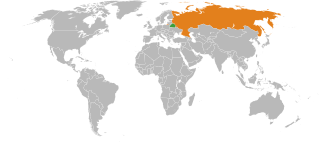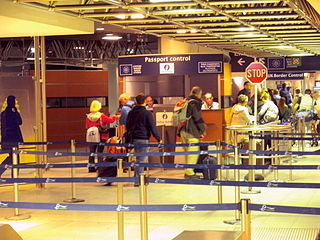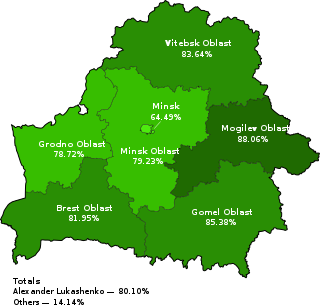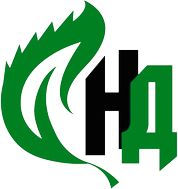
The politics of Belarus takes place in a framework of a presidential republic with a bicameral parliament. The President of Belarus is the head of state. Executive power is nominally exercised by the government, at its top sits a ceremonial prime minister, appointed directly by the President. Legislative power is de jure vested in the bicameral parliament, the National Assembly, however the president may enact decrees that are executed the same way as laws, for undisputed time.

Grodno or Hrodna is a city in western Belarus. It is one of the oldest cities of Belarus. The city is located on the Neman River, 300 kilometres (190 mi) from Minsk, about 15 kilometres (9.3 mi) from the border with Poland, and 30 kilometres (19 mi) from the border with Lithuania. Grodno serves as the administrative center of Grodno Region and Grodno District, though it is administratively separated from the district. As of 2024, the city has a population of 361,115 inhabitants.

Border control comprises measures taken by governments to monitor and regulate the movement of people, animals, and goods across land, air, and maritime borders. While border control is typically associated with international borders, it also encompasses controls imposed on internal borders within a single state.
Belavia, formally Belavia Belarusian Airlines, is the flag carrier of Belarus, headquartered in Minsk. The state-owned company had, as of 2007, 1,017 employees. Belavia serves a network of routes between Commonwealth of Independent States, as well as some Middle East destinations, from its base at Minsk National Airport.

The Union State of Russia and Belarus, officially also referred to as simply Union State, is a supranational union consisting of Belarus and Russia, with the stated aim of deepening the relationship between the two states through integration in economic and defence policy. Originally, the Union State aimed to create a confederation; however, both countries currently retain their independence.

Belarus and Russia share a land border and constitute the supranational Union State. Several treaties have been concluded between the two nations bilaterally. Russia is Belarus' largest and most important economic and political partner. Both are members of various international organizations, including the Commonwealth of Independent States, the Eurasian Economic Union, the Collective Security Treaty Organization, and the United Nations.

The Schengen Area encompasses 29 European countries that have officially abolished border controls at their mutual borders. As an element within the wider area of freedom, security and justice (AFSJ) policy of the European Union (EU), it mostly functions as a single jurisdiction under a common visa policy for international travel purposes. The area is named after the 1985 Schengen Agreement and the 1990 Schengen Convention, both signed in Schengen, Luxembourg.

Belarus and Lithuania established diplomatic relations on 24 October 1991, shortly after the dissolution of the Soviet Union. The two countries share 680 kilometres (420 mi) of common border.

The Eurasian Economic Union is an economic union of five post-Soviet states located in Eurasia. The EAEU has an integrated single market. As of 2023, it consists of 183 million people and a gross domestic product of over $2.4 trillion.

Visitors to Belarus must obtain a visa from one of the Belarusian diplomatic missions unless they are citizens of one of the visa-exempt countries.

The Customs Union of the Eurasian Economic Union or EAEU Customs Union is a customs union of 5 post-Soviet states consisting of all the member states of the Eurasian Economic Union which initially became effective on January 1, 2010 at the date of implementation of the common external tariff (CET) as the Customs Union of the Eurasian Economic Community or Customs Union of Russia, Belarus and Kazakhstan. It was inherited from the Eurasian Economic Community and is now regulated by Part Two of the Treaty on the Eurasian Economic Union, EAEU Customs Code, other international agreements and by decisions of supranational bodies as Supreme Eurasian Economic Council, Intergovernmental Council and Eurasian Economic Commission.

Juxtaposed controls are a reciprocal arrangement between Belgium, France, the Netherlands and the United Kingdom whereby border controls on certain cross-Channel routes take place before boarding the train or ferry, rather than upon arrival after disembarkation. With the exception of the Eurotunnel Shuttle route, customs checks remain unaffected by juxtaposed immigration controls and continue to take place upon arrival after disembarkation. Belgium, France and the Netherlands are all member states of the European Union and part of the border-free Schengen Area. The United Kingdom, on the other hand, has never participated in the Schengen Area, even when it was a member state of the European Union. As a result, juxtaposed controls aim to increase the convenience and efficiency of border checks when travelling by train or ferry between the Schengen Area and the UK by removing the need for immigration checks on arrival and by streamlining checks on departure. At the same time, juxtaposed controls are intended to detect and prevent illegal immigration. In 2016, there were over 56,000 instances when people were refused entry to the UK at the juxtaposed controls.

The Belarusian-Ukrainian border is the state border between Belarus and Ukraine with a length of about 1,084 km (674 mi). It starts from the triple junction with Poland to the west and stretches to the triple junction with Russia to the east. The tripoint border at the triple border junction of Belarus, Russia and Ukraine is marked in the form of a monument, while at the other border junction there is a river, the Western Bug that coincides with the border of Poland.

Valery Vilyamovich Tsepkalo or Valery Vilyamavich Tsapkala is a Belarusian politician and entrepreneur. After graduating from the Moscow State Institute of International Relations with a doctoral degree in international law and serving in the embassy of the Soviet Union in Finland, Tsepkalo joined the staff of the Belarusian Ministry of Foreign Affairs. He later became an advisor on foreign political and economic relations to the Chairman of the Belarusian Parliament, Stanislav Shushkevich, and then a senior advisor to the Secretary General of the Commonwealth of Independent States.

The impact of Brexit on the Irish border and its adjacent polities involves changes in trade, customs, immigration checks, local economies, services, recognition of qualifications, medical cooperation, and other matters, as it is the only land border between the United Kingdom and the European Union.

Presidential elections were held in Belarus on Sunday, 9 August 2020. Early voting began on 4 August and ran until 8 August.
OMON or AMAP is a riot police force under the Ministry of Internal Affairs of the Republic of Belarus (MUS) that specialized in combat and patrolling in urban areas, counter-revolutionary, covert operation, crowd control and riot control when people or prisoners who are involved in a riot, unlawful demonstration or unlawful protest, high-risk law enforcement situations, HUMINT, and internal security.

The National Democratic Alliance is a social and political movement in the Russian Federation. It supports the creation of several Russian republics, the re-establishment of the Federation, and the establishment of a single federal agreement between the subjects of the Russian Federation. The NDA is co-chaired by Alexey Shiropaev, Ilya Lazarenko, and Mikhail Pozharsky.
Controls imposed on internal borders within a single state or territory include measures taken by governments to monitor and regulate the movement of people, animals, and goods across land, air, and maritime borders through border controls.

The Agreement on Customs Union between the Russian Federation and the Republic of Belarus was concluded in Minsk on 6 January 1995 between the Government of the Russian Federation by Viktor Chernomyrdin and the Government of the Republic of Belarus by Sergey Ling in two original copies in the Russian and Belarusian languages, both texts being equally authentic. According to the website of the Eurasian Economic Union, “Applies to the extent not contradicting the Treaty on the Eurasian Economic Union of 29 May 2014”. The Depositaries are the Republic of Belarus and the Russian Federation.
















